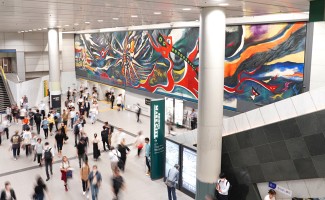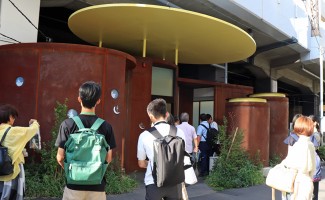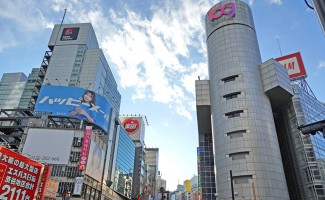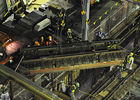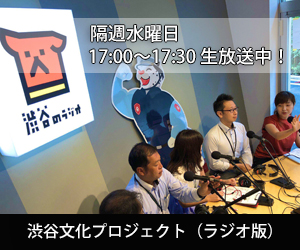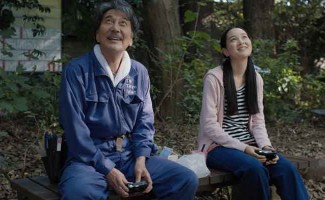Let's chat about Shibuya "He says, She says"
Shinto priestFlorian WiltschkoAnd innovation specialistChiaki HayashiGet together to chat about the fascination and the future of Shibuya
Priest, and Wiruchiko-Florian, loft work representative director, Chiaki Hayashi talks about Shibuya of charm and future.
In order to talk about the future, we also need to unravel history. As a Shinto priest at the Konno Hachimangu Shrine in Shibuya, Austrian Florian Wiltschko is well versed in the history of Shibuya. Chiaki Hayashi, meanwhile, is a representative director at Loftwork and specialises in the creation of innovation through technology and design. We brought them together for a discussion about Shibuya’s past and future.
To talk about the future is also to Disclose the history. The responsible for the history of Shibuya, a priest of the historic gold king Hachiman Shrine, born in Austria Wiruchiko Florian. On the other hand, the responsible for the future of Shibuya, but Chiaki Hayashi of loft work representative directors who orchestrated the innovation with technology and design. Invited the two of them, we had talked about the past and future of Shibuya.
Hayashi:The first time I came to Konno Hachimangu Shrine was to attend a TED launch party. I was amazed at how it was solitary all the modern buildings, and also how the shrine was able to provide its support for global projects.
H: The gold king Hachiman Shrine, but I was for the first time came when the launch party of the TED has been carried out, was surprised to be between this building. Shrine is also that that will support the global planning.
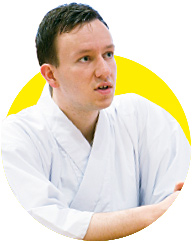
Wiltschko:This is the oldest wooden building in Shibuya Ward, so there is definitely a gaped bridged by holding a modern event like TED here. TED here. TED here. Hashiman, the god worshipped at this shrine, was considered to be the strongest god in the whole country, so was therefore chosen to Be the bodyguard of Buddha.
W: This building, in the oldest wooden building in Shibuya-ku, I think that there is a gap to open the contemporary events in such a place. But the shrine was originally, I came to accept new things. A good example is in Buddhism, once when introduced from abroad, not only accept, I'm a much was linked to the ancient Japanese god. Because Hachiman like that are enshrined in this shrine, as the strongest God in the whole country, I was elected to the body guard of a guest Buddha.
H:Is that right?
H: Do you was true?
W:Shrines are not historic ruins. Even Yes, proof of this is that large Buddhist temples always have a Hachiman Shrine on the side. Shrines closest to the large. Statue of Buddha in Nara is not actually the Kasuga Grand Shrine, but a Hachiman Shrine. They are very much still alive.
W: Yeah, always in the place where there is a large temple on the evidence, will be a Hachiman Shrine on the side. The nearest shrine to the Great Buddha of Nara is actually not the Kasuga Shrine, I know Hachiman. Jinja is not the ruins. Now also be required, it is used, the thing alive.
H:One of the things I am most interested in right now is history. I feel that in order to find out why something is done in a particular land, we need to connect with that land's history.
H: Actually I, I know history that is most interested in now. Why it means to do it in the land, if the steward history and a string of land, and I think in the wind that Do would disappeared immediately in many cases.
W:In that sense, a shrine is part of the land itself. Long ago, it was believed that each land had its power, and this strength was the god's power. This is why people would treat the gods with kindness and respect, in exchange for being allowed to use their precious land. And this is why they built the shrines.
W: In terms of that sense, the shrine is said to land itself. Long ago it was thought to have the power to every single land. The force is, that it is the power of God. To or there is a natural disaster, because God is angry. So the old man, instead of get to use the precious land of God, we have a contract that deal cherish God. So we were prepared God's house that shrine.
H:This is linked to why I decided to base my office in Shibuya. As I heard more about its history, I started thinking that maybe this is because the area has its own god.
H: This is I'm leading to talk of why I work in Shibuya, when I was thinking where to try to put the office, inspiration that, pleasant feel like I can work is if there is a company in this area there, I was in when I was walking down the Shibuya. It is, in the wind that I wonder if such because there are God's land, I thought I heard a story.
W:There are all sorts of energies at play here. I think the gods in Shibuya are extremely busy [laughs].
W: This area is in addition to the office, residential also commercial facilities. I because there are all energy. Shibuya of God, I think that busy. (Lol)
H:If we take the energy held by the land and include all the things that can not be articulated, and call it culture, I believe the place that will create the culture of the future will be Shibuya. Our company specialises in finding ways of using design and technology to create new things, and we believe that new things are not born from the same direction that everybody else is looking at.
H: If you, including those that can not be energy and the language of the land have referred to as a culture, I am, going to create a following of culture, I think that it is Shibuya. Of which is I'm a company to challenge or possibly can how new in design and technology, that, but the new ones, I'm everyone is not born in a place that is oriented in the same direction.
W:Over the years, Shibuya has been developing the foundations of culture. Shibuya starts from the warriors that came originally from Chichibu, who created their own military movements, receiving the land and name of Shibuya. It was then that they Started worshiping Hachiman as their own guardian deity. Until the Meiji (Watching Hachiman as their own guardian deity. Until the Meiji, a base for the shogunate, becoming a central hub of transportation. However, the basic elements that attracted people here were the shrine, the transportation hub and the river.
W: Shibuya've developed the foundation of the culture from time immemorial. The history of Shibuya of birth, samurai came out from Chichibu is, you start that I got the name and the land that Shibuya make a military exploits. There, dedicated to Hachiman-like as his guardian angel. As shrine aside, was once have led to there was a shogunate Kamakura, become the center of the traffic. Then now is if there is a river that is hidden. Here until the Meiji era was a rural district of the suburbs, foundation where people gather, and the shrine, and the street, I was in the river.
H:By fact, Shibuya has the highest concentration of creative cafés by the cultural anthropologist that this was because factories are originally lined up along with the river, creating a town that specialized in manufacturing. By unravelling history, We can understand why everybody wants to create things in Shibuya.
H: Actually, it's also Shibuya of Toka laser cut, a cafe that can new Manufacturing is the most integrated. It is, if there is originally factory along the river, and because it was a city that manufacturing has been carried out, it is said to the people of the cultural anthropologist. And Disclose the history, it it can be seen why everyone's will want to make things in Shibuya.
W:By understanding history, we can understand why we are here, as well as what sorts of things we should not do.
W: History It is must not be neglected. Knowing the history, why here myself are, What do you do you will be seen that do not you.
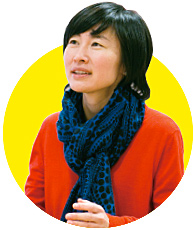
H:If you think about places that keep cultural alive from the past. Towns that are optimized based on economics and politics have no need to think about history. I get the feeling that new things are born from going back further and history into.
H: most strongly leave town the culture, to think of where you will lead alive the culture from the past, I think that it is Shibuya in Tokyo. Efficiency of the city is the foundation of the economy and politics, but it is not necessary to think about the history. On the other hand, Toka theater house Toka musician, a person to create something is to have the starting power to the world, you will need to decipher the country's history. New things I, and feel like born by getting back in history.
W:I would like Shibuya to be a place that never forgets its roots. We are always a good for us to know that, if we were to lose our way, we would always have a place to come back to.
W: now also Shibuya, I want a city that does not forget the roots. Although we have more and more changes of the times it is fast, if you lose sight of the destination, there is go home place, is because it is important for that.
H:This is a traditional technique handed down through generations of shrine carpenters, so buildings are built by interlocking blocks of wood, without There are many people who are using shrine carpenters. So this is an experiment to encourage others to use one more this technique technique of interlocking wood blocks.
H: Now, by using a 3D printer, we're trying to teach a set tree techniques that are used in the shrine. Without the use of nails, but is a traditional technique transmitted to Miyadaiku to make the building a combination of wood, lurking is wisdom that is changed into only part outdated. Among the young people to become Miyadaiku has decreased, so that the hope that it anew Japan set of trees that have technology, or ask them to understand how to data of the technology, why to understand what it was born to get an attempt.
W:The best way to learn about culture is to come in contact with it. Fashion Week here, to give people an opportunity to visit a historical location.
W: The best way to know the culture is to try to actually touch. For example, as a chance to set foot on the shrine is a Japanese roots, there are events such as Fashion Week but it is a good thing.
H:There are many places in Japan where special experiences can only be had by visiting them in person. Perhaps there are many foreigners who wish to visit Japan precisely because these things can not be simply packaged up and exported.
H: Japan to things that can not be experienced only on the spot and, because there are a lot of things that do not taste only that do. Precisely because not a thing that can export anywhere to package, perhaps there are many foreigners that want to go to Japan.
W:Absolutely. What you can only experience at a particular location has the value of that place.
W: I think you say street. And that can not be experience and not feel the air in the skin, to leave the things that can not be internationalization, I think that it also leads to tourism.






